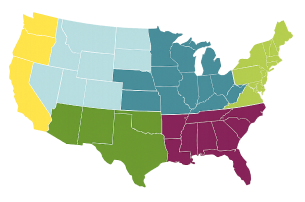By Chy Allen and Ray Allen, Founders of AmericanMeadows.com
Here's a quick explanation of how plants are classified from Kingdom, the highest division, all the way to Variety, the lowest. Remember, a common wildflower like Black-eyed Susan is called Rudbeckia hirta. Rudbeckia is the Genus name. Hirta is the Species. You’ll find these two sub-divisions way down on this list.
An Example of Plant Classification
Black-eyed Susan
Rudbeckia hirta
| Kingdom |
Plantae – Plants |
| Subkingdom |
Tracheobionta – Vascular plants |
| Superdivision |
Spermatophyta – Seed plants |
| Division |
Magnoliophyta – Flowering plants |
| Class |
Magnoliopsida – Dicotyledons |
| Subclass |
Asteridae |
| Order |
Asterales |
| Family |
Asteraceae – Aster family |
| Genus |
Rudbeckia – coneflower |
| Species |
Rudbeckia hirta – black-eyed Susan
|
Source: USDA
Explanations of Classifications (beginning with "Class")
- I. Class
-
Class divides plants into the two large groups, Dicots and Monocots.
A. Dicotyledons (Dicots are plants with two seed leaves.
This huge group, with approximately 2/3 of all flowering plants, includes most
all wildflowers. Dicots have "net-veined" leaves, which means they have the
familiar leaves with center vein plus branching veins running from it.
B. Monocotyledons (Monocots, plants with one seed leaf,
are the grasses and other simpler plants, and make up about 1/3 of all flowering
plants. Monocots have parallel-veined leaves.)
- II. Subclass (Not used with all species.)
- A group of related plant families classified in the order in which they are believed to have developed their differences from a common ancestor. There are six "superorders" with each one’s name ending in "idae."
- III. Order (Not used with all species.)
- The classes are further sub-divided into "orders" whose names end in "ales."
- IV. Family
- Each order is divided into families. Each member of a plant family shares many botanical features. This is the highest classification group normally referred to. Modern classification assigns a type of plant to each family as an example of that family’s characteristics as distinguishable from other families. The names of families end in "aceae."
Click here for a list of Wildflower Families
- V. Sub-Family (Not used with all species.)
- A sub-division of a family in which plants are grouped according to botanical differences within the same family. Sub-families end in "oideae."
- VI. Tribe (Not used with all species.)
- A further family division based on less significant botanical differences. Tribes end in "eae."
- VII. Sub-Tribe (Not used with all species.)
- A further division based on even smaller botanical differences, usually only recognizable by professional botanists.
- VIII. Genus
- This is the part of plant nomenclature that is the most familiar. For example, Papaver is the genus for Poppy. Plants in a genus are easily recognizable as belonging to the same group. The name of the genus should always be capitalized. Example: Red Poppy is Papaver rhoeas.
- IX. Species
- This is the level of classification that defines the individual plant. Here some aspects of the plant are more specifically defined — color, leaf shape, or place where or by whom it was discovered. The use of the genus and species names together always refer to only one plant. The species name is written after the genus and is never capitalized. Example: Rudbeckia hirta
- X. Variety (Not used with all species.)
- To receive this added piece of nomenclature, a plant must be only slightly different from a certain species, but not different enough to be granted its own species name. When used, the Variety name follows the Genus and Species names with the abbreviation, "var," followed by the full variety name in small letters. The wildflower Scarlet Flax is a good example: Linum grandiflorum var rubrum. In Latin, this tells you that this is a Flax (linum) with large flowers (grandiflorum) that happen be red (rubrum). (Most of the family is not red-flowered.) Most wildflowers do not have this extra little added-on name, (for example, Rudbeckia hirta does not.) but it’s important when needed.
